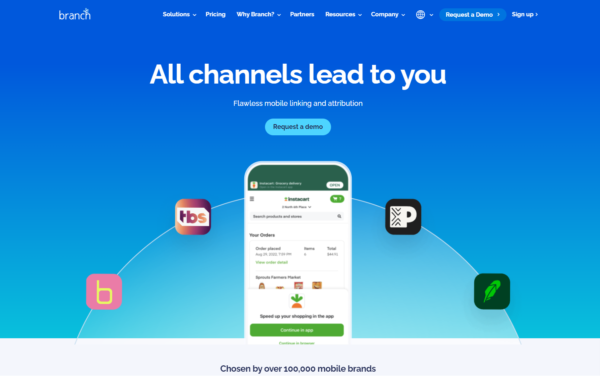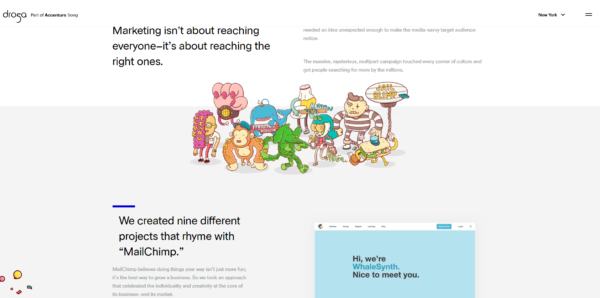ABM vs Traditional Marketing: A Guide For B2B Marketers
Summary
15 Best SaaS Marketing Blogs You Should Follow in 2024
Marketing is a very broad term and there are a plethora of marketing strategies that businesses can leverage to gain visibility, attract customers, and grow their business. In this ever-evolving landscape of B2B marketing, the two prominent approaches offering the highest Return on Investment are Account-Based Marketing and Traditional Marketing.
There are advantages and disadvantages to each of the strategies, but it’s important to understand what they are and when you should be using them. In this article, we talk about ABM vs Traditional Marketing and understand how marketers can utilize them to their fullest.
What is Account Based Marketing?
Account Based Marketing (ABM) involves targeting and reaching out to a specific set of high-value accounts or companies instead of casting a wide net to attract leads. This strategic B2B marketing approach tailors the efforts to satisfy the needs, interests, and pain points of individual accounts, often customizing messaging and content.
Pros of ABM
1. Highly-focused Targeting
The most beneficial advantage of ABM is that it allows marketers to target a specific high-quality set of audiences. This ensures that the marketing efforts are highly targeted and efficient which promises better lead conversions. Here, businesses may be reaching a few customers, but those customers are of superior quality, and catching such leads can help in rapid business growth.
2. Offers Personalization
Personalization is the key ingredient of ABM. It emphasizes that marketers tailor the messages, emails, social posts, and other website content that call out to the targeted customers’ requirements. In fact, about 49% of marketers agree that ABM helps them in making their company customer-centric. This personalization is also helpful in fostering stronger relationships and loyalty among the customers.
3. Higher Return on Investment (ROI)
Every marketing effort put in by marketers comes down to one thing – Return on Investment (ROI). Due to its highly focused approach, 87% of marketers also believe that Account Based Marketing (ABM) frequently offers a higher ROI compared to any other marketing strategies. This difference between ABM vs traditional marketing is often the reason why marketers prefer ABM, especially when the objective is to enhance returns.
4. Better Sales Alignment.
When implementing ABM, the sales and marketing efforts go hand in hand. More than 82% of marketers believe that ABM plays a major role in improving sales and marketing collaborations. Since ABM encourages closer collaboration between sales and marketing teams, it also leads to better alignment in targeting key accounts and generating more leads efficiently.
5. Calculative Results
Metrics like engagement gauged on accounts, conversion rates, and revenue growth from specific accounts can be used to measure the success of your ABM campaign. This tracking provides clear insights on how effective the ABM has been and makes the results measurable which can further help in better decision-making and planning.
Cons of ABM
1. Requires More Resources
As effective as Account Based Marketing may seem, it does come with a significant cost. ABM demands significant investment in resources like time, personnel, tools, and technology to make it successful. This drawback of ABM makes it less suitable for smaller companies that have limited resources to spend.
2. Limited Audience Reach
Account Based Marketing is great at targeting a small set of audiences or a few individuals. However, if marketers are looking to target a wide range of audiences, then ABM is not the best option. It limits the overall reach of marketing, risking the loss of multiple customers or clients.
3. Longer Sales Cycle
Account Based Marketing is a strategy that demands sustained effort over an extended period. This B2B marketing strategy requires marketers to nurture long-term relationships with customers and be patient while capturing leads, thus extending the sales cycle.
What is Traditional Marketing
Traditional Marketing involves the old-school methods of marketing to reach the target audience. It includes methods like advertising on television, radio, print media, billboards, cold calling, as well as direct mail. Contradictory to Account Based Marketing, traditional marketing focuses on reaching out to a large pool of customers.
Pros of Traditional Marketing
1. Wider Audience Reach
Traditional Marketing holds the potential to reach out to a wider audience across multiple channels. This ensures better brand visibility and mass reaching which can ultimately make sure that more and more customers are made aware of and attracted to the brand. It is in fact observed by marketers that conventional channels can create a strong brand image and build trust which can be useful in long-term success.
2. Requires Lesser Resources
Another great advantage of traditional marketing is that it’s not very resource-intensive. Since such campaigns are focused on mass media, they often require lesser resources regarding one-on-one interaction, personalization, and research. This makes traditional marketing a great tool for smaller organizations or for businesses to whom personalization is not as crucial.
3. Cost-efficient in Mass Marketing
Traditional marketing techniques frequently present cost-effective options for mass marketing. For example, printing an ad in a newspaper or airing a radio commercial may have a better cost-per-audience ratio when it targets a large audience instead of creating highly personalized campaigns dedicated to individual high-value accounts. For cases where budget limitations are a factor, traditional marketing is always an affordable alternative.
4. Fast Implementation
Traditional marketing doesn’t invest much time in research like finding the particular customer demographics or scheduling as done in ABM. These campaigns can be relatively launched quickly. For example, if you wish to hand over flyers, send direct mail, or cold call your customers, it can be done within a shorter span of time. Thus, traditional marketing is best for time-sensitive promotions or events.
5. Established Channels
When it comes to implementing traditional marketing, channels like television, radio, and print media are very well established. This makes the implementation highly reliable and familiar for reaching out to customers.
Cons of Traditional Marketing
1. Lacks Targeting
The biggest drawback of traditional marketing is it lacks targeting capabilities found in digital marketing strategies such as Account Based Marketing.
Here, messages are generally broadcasted to a wide audience without considering specific demographics, interests, or needs. This absence of targeting can lead to decreased conversion rates and less effective utilization of resources, as marketing efforts may not reach the most potential customers. Without clear targeting, traditional marketing campaigns may fail to resonate with the desired audience.
2. Difficult to Measure ROI
Measuring ROI in traditional marketing is more challenging compared to digital channels like social media advertising or email marketing. Traditional campaigns often depend on indirect metrics like brand awareness or impressions, complicating the calculation of specific outcomes to marketing efforts.
Quantifying the impact of traditional initiatives such as TV ads or print media on sales can be complex and intuitive. Lack of clear ROI measurement makes it harder for businesses to justify marketing expenses and improve their strategies for optimal results.
3. Lacks Impact
It’s been recorded that traditional marketing brings in less than 50% of interactions with customers as compared to digital marketing tactics like ABM. In today’s digital era, people are bombarded with advertisements, and due to the shorter attention span of the customers, it’s obvious for traditional marketing to miss the impact.
People have become largely selective in what they wish to see, and traditional methods like television, radio, or print media may fail to capture the attention of the modern crowd. In contrast to interactive and engaging digital marketing campaigns, traditional marketing tactics are outdated and irrelevant to an audience that is now highly tech-savvy.
Key Differences Between ABM and Traditional Marketing
Similar to everything, AMB and traditional marketing also have their merits and demerits. But along with those, there are also a few key differences between Account Based Marketing and traditional marketing that are a must know.
1. Targeting
ABM
The number one difference between Account Based Marketing vs traditional marketing is the nature of targeting customers. ABM works by targeting specific high-value profiles and 85% of marketers anyways believe that targeting and personalization in such campaigns is more effective than traditional marketing.
It includes identifying key accounts that align with the ideal customer accounts and tailoring marketing efforts to resonate with those customers’ needs and interests. ABM relies on precise targeting to ensure higher engagement and conversion rates within a specific group of accounts.
Traditional Marketing
Traditional marketing focuses on a broader approach, targeting a wide audience across various demographics. Messages are often distributed through traditional mass media channels such as television, radio, or print media, with less emphasis on targeting specific accounts or individuals. Traditional marketing casts a wider net in the hope of reaching a larger pool of potential customers.
2. Personalization
ABM
Personalization is the heart of ABM. In this, every marketing piece of content is customized and tailored to address the unique needs, interests, behaviours, and pain points of individual accounts. These may include personalized emails, messaging, or event offers that are relevant to each profile. This personalization in emails aims at fostering longer and deeper relationships with customers leading to higher engagement and conversions.
Traditional Marketing
Traditional marketing often lacks personalization. Content is usually standardized to suit a wider audience and not individual preferences. Though some measures can be employed to advertise relevantly, the efforts of marketing are generally less personalized than Account Based Marketing.
3. Measurement of Data
ABM
The measurement and tracking of data is more precise with ABM vs traditional marketing. ABM allows marketers to assess and track the engagement and interactions of customers throughout their online journey, enabling marketers to draw accurate results. Metrics such as engagement rates, conversion rates, pipeline velocity, and revenue generated can be easily calculated so that markets can assess the effectiveness of their ABM campaigns.
Traditional Marketing
It’s harder to calculate the impact of traditional marketing since it lacks tools and platforms to collect data. These strategies often depend on metrics like impressions or brand awareness, making it challenging to pin down any outcomes. For example, one can not calculate how many people interacted with the ads on TV, radio, or in newspapers. Marketers may try to leverage tools like research surveys to get some insights, however, the tracking of traditional tends to be less precise compared to ABM.
4. Resource Requirement
ABM
Successful implementation of Account Based Marketing requires the utilization of several resources including time, personnel, tools, and technology. Marketers must closely collaborate with sales and customer support teams to determine target accounts, create personalized content, and execute custom campaigns. In addition to these efforts, ABM also emphasizes leveraging tools to measure the success of the campaigns.
Traditional Marketing
If compared between ABM vs traditional marketing, traditional marketing requires lesser resources. Although costs involving running ads on TV and radio or printing a billboard are something to consider, the traditional methods often involve less resource-intensive customization and targeting. This overall proves to be a better strategy for low-budget companies.
5. Sales and Marketing Collaboration
ABM
ABM encourages the marketing and sales departments to work closely with each other. This collaboration results in better alignment in targeting key accounts and generating revenue growth. It promotes joint planning and execution so that the data can be interchangeably used by each team and leveraged for nurturing and engaging high-value accounts.
Traditional Marketing
The level of integration and collaboration between the sales and marketing teams is not so profound in traditional marketing as compared to ABM. traditional marketing often requires marketers to plan and execute marketing campaigns independently. There’s no substantial involvement from sales when it comes to creating or implementing marketing strategies.
Now that we know the clear difference between account based marketing vs traditional marketing, let us provide you with a table for a more concise and precise overview:
| Basis | ABM | Traditional Marketing |
| Targeting | Focuses on specific high-value accounts. | Focuses on a wider audience demographic. |
| Personalization | Involves a high level of personalization of content. | Standardized content is used for the mass public. |
| Measurement of Data | Tracking and measuring is easy in ABM with metrics like conversion rates, pipeline velocity, etc. | Measuring the impact is difficult as it relies on subjective and indirect metrics. |
| Resource Requirement | Requires more resources for implementation. | Requires fewer resources for implementation. |
| Sales and Marketing Collaboration | Encourages close collaboration between marketing and sales. | The emphasis on the collaboration of sales and marketing is not profound. |
When to Use ABM?
Account Based Marketing must be leveraged at its best when you’re looking to target a specific group of audience that holds high value in terms of conversions. It’s best suited for B2B businesses that are trying to foster longer relationships with customers and penetrate new markets. There are a few situations in which ABM can be highly effective such as:
High-value Target Audience
If you’re in a business where you have a small base of customers that are particularly of high value, then ABM can be a great strategy to channel your marketing efforts towards them to achieve success.
Specialized Product or Service
Having a regular product may not require the level of personalizing precision. However, if you’re product or service is very unique and special, then you may need ABM tactics to reach and educate your customers about it in an effective manner
Long Sales Cycles.
ABM is suitable for businesses having longer sales cycles and where the decision-making involves multiple investors. Thus, if your business needs to nurture long-term relationships with customers in order to generate consistent revenue, then using Account Based Marketing strategies is a must.
Examples of Successful Account Based Marketing Campaigns
Account Based Marketing has been proven to generate better ROI and engagement results where more than 75% of marketers already use ABM to improve customer retention rates.
Here are a few examples of companies already using Account Based Marketing:
1. LiveRamp
LiveRamp is a data collaboration platform that provides the transfer of offline data online for marketing purposes. The company was aiming to win over and onboard some of the world’s largest organizations.

LiveRamp leveraged account-based B2B marketing to promote speed and effectiveness in its global campaigns like onboarding and multi-channel marketing by focusing on the right list creation and multichannel activation. They did this by targeting high-value customers through individual messages, personalized display ads, email promotions, and SDR touchpoints.
The result? 33% conversion rates from cold leads within 4 weeks and booking of meetings with multiple Fortune 500 companies. They also managed to revive old accounts and convert some very loyal customers. In over 2 years of ABM execution, LiveRamp saw a 25 times increase in customer LTV.
2. Branch
Branch, a deep-linking mobile attribution company helps its customers by allowing them to measure their ROI by monitoring customer behavior. The company was struggling to improve and increase its conversion rates but was failing to do so.

Branch already has a gifting strategy in place but it faced challenges due to manual processes and poor alignment between sales and marketing teams. They were in a two-month delay in sending gifts.
However, they didn’t give up on their ABM tactic by adopting Alyce, a modern gifting platform that enables reps to personalize gifts quickly. The campaign extended beyond gifting, leveraging email, social media, and phone call campaigns to engage prospects which increased their chances of booking a meeting with each touchpoint.
With consistent efforts, Branch saved more than 30 hours in campaign setup and tracking, achieved 2 six-figure deals, and worked out an 18:1 pipeline-to-spend ratio.
When to Use Traditional Marketing
Traditional marketing is best for businesses that are aiming to reach a broader audience and want to promote mass-audience services or products. Here are a few situations where traditional marketing may be particularly effective:
Wide but Specific Audience
Traditional marketing is great at engaging and reaching a certain audience with specific demographics or locations. For example, if your buyer personas fit in the age group above 60, then you may want to consider traditional marketing methods like print media or radio.
Aiming Brand Visibility
Brand visibility is improved when your business reaches more and more customers in a shorter span of time. To support this, traditional marketing methods are perfect. For example, you can talk about your products and services to a wide audience through television ads, however, sharing and running a targeted email marketing campaign might be less effective in covering such large groups.
Supporting Digital Marketing Efforts
Around 45% of small businesses invest in both digital and traditional marketing channels. Traditional marketing efforts can help in pushing and multiplying the efforts put into digital marketing. For example, you can make use of print media or television ads to drive traffic to your digital marketing campaigns like to your social media page.
Examples of Successful Traditional Marketing Campaigns
Traditional marketing is still relevant to this day and the MarketingSherpa survey reveals that more than 80% of customers still trust print and TV ads. Whereas, more than 70% of the people trust direct mail and radio advertising.
As discussed above, for businesses targeting broad audience demographics aiming for brand visibility, traditional marketing is a boon to them.
Here are a few examples of companies who’ve been getting great results through this strategy:
1. MailChimp
MailChimp, an email marketing and automation platform decided to run a creative and engaging campaign to grab the attention of its potential customers. MailChimp’s “Did You Mean MailChimp?” campaign must be one of the most talked about traditional marketing campaigns we believe.

In collaboration with Droga5, the company launched humorous ads across TV, radio, billboards, and print media, focusing on the mispronunciation of their brand name. With a multi-channel approach targeting various audiences, the campaign successfully gained widespread attention and appreciation for its humorous and creative approach.
This resulted in increasing brand awareness and customer acquisition for the company.
2. Slack
Slack is an amazing communication and team collaboration platform. This SaaS company wanted to stand out from the rest of its competitors and highlight its key features and benefits. Thus, giving rise to Slack’s “Work, Simplified” Campaign.

This amazing traditional marketing campaign aimed at simplifying work processes and boosting productivity. They utilized billboards, print media, and transit ads to reach professionals in key business districts.
Additionally, Slack sponsored industry events, showcasing their platform’s benefits firsthand. This campaign successfully positioned Slack as a top choice for workplace communication and collaboration, powering its rapid growth and adoption across businesses of all sizes.
Conclusion
In today’s rapidly evolving B2B marketing landscape, both Account Based Marketing and Traditional Marketing have their place, each offering distinct merits and demerits.
While ABM focuses on targeting high-value accounts with personalized messaging, traditional marketing strategies remain relevant for reaching a broad audience and building brand awareness. By understanding ABM vs traditional marketing and knowing when to leverage each approach, B2B marketers can optimize their strategies and drive success in their marketing efforts.


